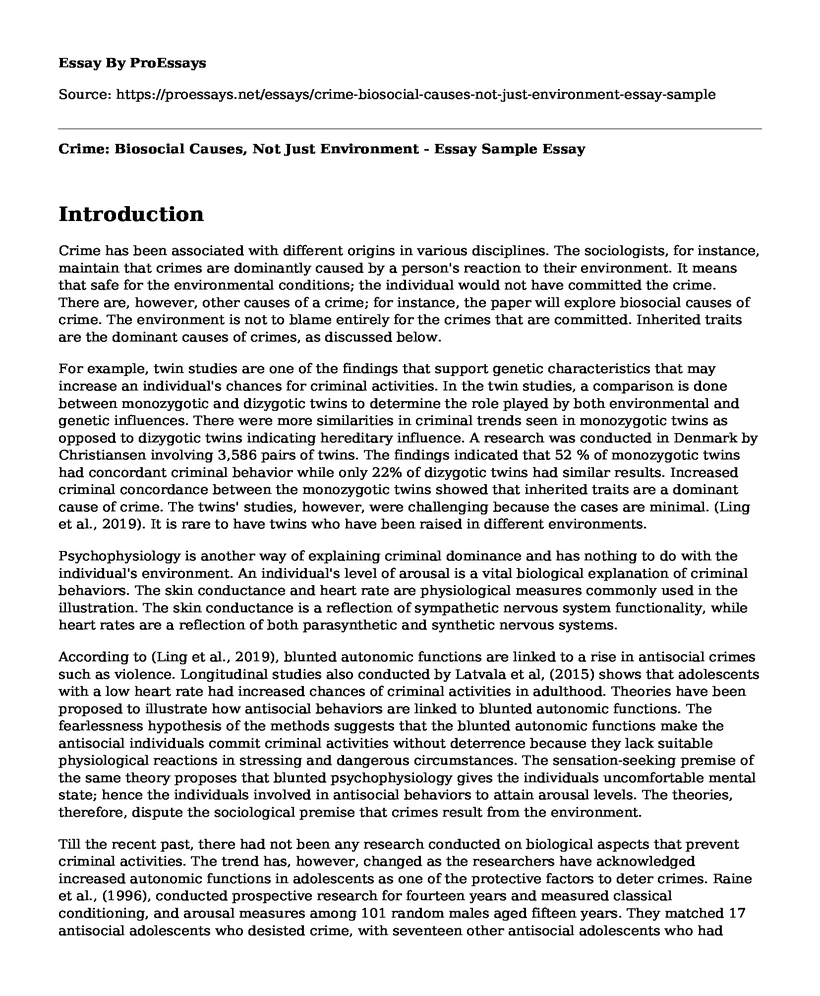Introduction
Crime has been associated with different origins in various disciplines. The sociologists, for instance, maintain that crimes are dominantly caused by a person's reaction to their environment. It means that safe for the environmental conditions; the individual would not have committed the crime. There are, however, other causes of a crime; for instance, the paper will explore biosocial causes of crime. The environment is not to blame entirely for the crimes that are committed. Inherited traits are the dominant causes of crimes, as discussed below.
For example, twin studies are one of the findings that support genetic characteristics that may increase an individual's chances for criminal activities. In the twin studies, a comparison is done between monozygotic and dizygotic twins to determine the role played by both environmental and genetic influences. There were more similarities in criminal trends seen in monozygotic twins as opposed to dizygotic twins indicating hereditary influence. A research was conducted in Denmark by Christiansen involving 3,586 pairs of twins. The findings indicated that 52 % of monozygotic twins had concordant criminal behavior while only 22% of dizygotic twins had similar results. Increased criminal concordance between the monozygotic twins showed that inherited traits are a dominant cause of crime. The twins' studies, however, were challenging because the cases are minimal. (Ling et al., 2019). It is rare to have twins who have been raised in different environments.
Psychophysiology is another way of explaining criminal dominance and has nothing to do with the individual's environment. An individual's level of arousal is a vital biological explanation of criminal behaviors. The skin conductance and heart rate are physiological measures commonly used in the illustration. The skin conductance is a reflection of sympathetic nervous system functionality, while heart rates are a reflection of both parasynthetic and synthetic nervous systems.
According to (Ling et al., 2019), blunted autonomic functions are linked to a rise in antisocial crimes such as violence. Longitudinal studies also conducted by Latvala et al, (2015) shows that adolescents with a low heart rate had increased chances of criminal activities in adulthood. Theories have been proposed to illustrate how antisocial behaviors are linked to blunted autonomic functions. The fearlessness hypothesis of the methods suggests that the blunted autonomic functions make the antisocial individuals commit criminal activities without deterrence because they lack suitable physiological reactions in stressing and dangerous circumstances. The sensation-seeking premise of the same theory proposes that blunted psychophysiology gives the individuals uncomfortable mental state; hence the individuals involved in antisocial behaviors to attain arousal levels. The theories, therefore, dispute the sociological premise that crimes result from the environment.
Till the recent past, there had not been any research conducted on biological aspects that prevent criminal activities. The trend has, however, changed as the researchers have acknowledged increased autonomic functions in adolescents as one of the protective factors to deter crimes. Raine et al., (1996), conducted prospective research for fourteen years and measured classical conditioning, and arousal measures among 101 random males aged fifteen years. They matched 17 antisocial adolescents who desisted crime, with seventeen other antisocial adolescents who had become criminals at the age of twenty-nine. Those who ceased criminal activities had higher scores in physiological measures as opposed to those who turned into criminals (Raine et al., 2002). High arousal levels were therefore seen to protect antisocial boys from criminal activities.
Conclusion
These research findings are evidence that environmental factors cannot be used as an explanation for crime dominance. However, genetic traits and physiology processes are the major causes of crime. The individuals have either inherited the criminal traits or engage in criminal activities to increase their arousal levels.
References
Ling, S., Umbach, R., & Raine, A. (2019). Biological explanations of criminal behavior. Psychology, Crime & Law, 25(6), 626-640. https://www.ncbi.nlm.nih.gov/pmc/articles/PMC6640871/
Raine, A. (2002). The biological basis of crime. Crime: Public policies for crime control, 43, 74. http://www.antoniocasella.eu/nume/Raine_2002.pdf
Cite this page
Crime: Biosocial Causes, Not Just Environment - Essay Sample. (2023, May 22). Retrieved from https://proessays.net/essays/crime-biosocial-causes-not-just-environment-essay-sample
If you are the original author of this essay and no longer wish to have it published on the ProEssays website, please click below to request its removal:
- Cybercrime: Local to Global Essay Example
- Are People Born Criminals? Essay Example
- Essay Sample on Effect of Architecture in Reducing Crimes: St. Louis Missouri vs. Oklahoma City
- Technologies in Criminal Justice
- Essay Sample on Harriet Tubman's Fight for Civil Rights: A Historical Perspective
- Capital Punishment: Lawful Death Penalty for Level One Criminal Offences - Essay Sample
- Essay Example on Genetic Privacy: Guidelines for Judging Cases & Benefits for Society







